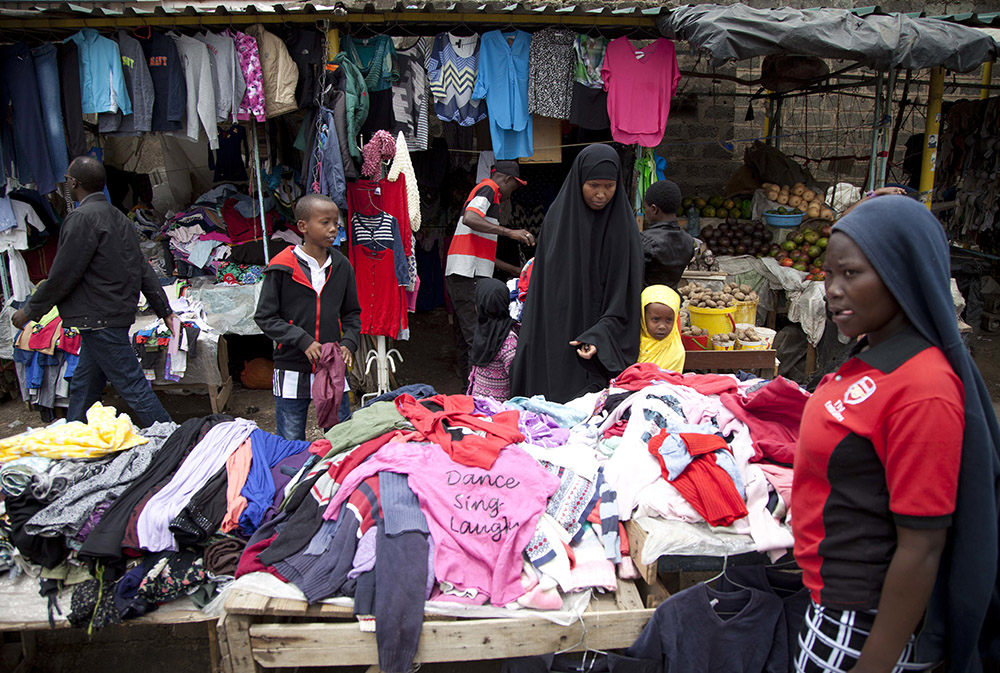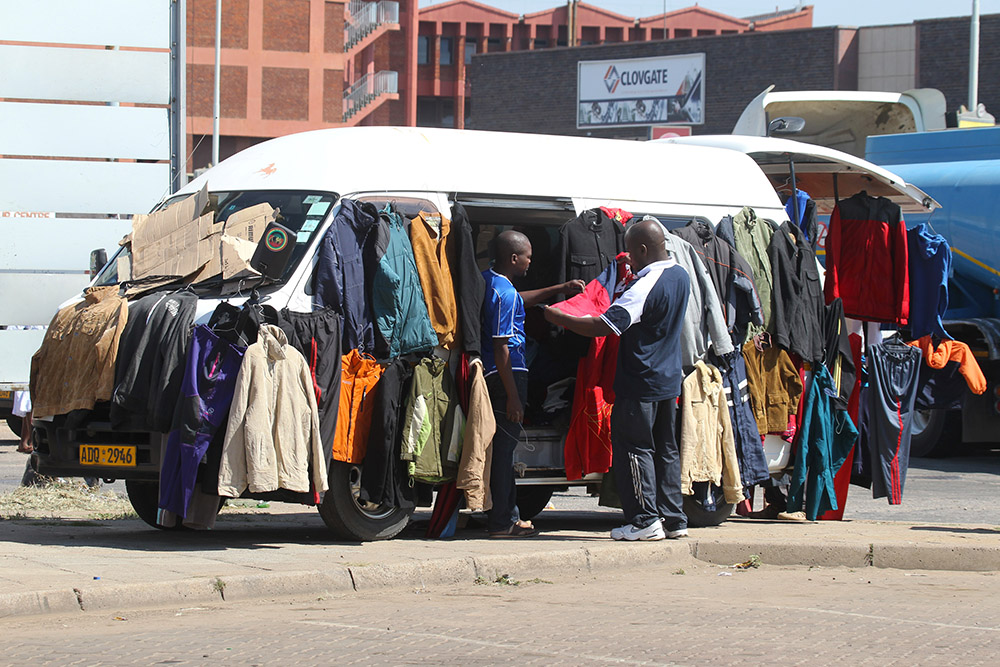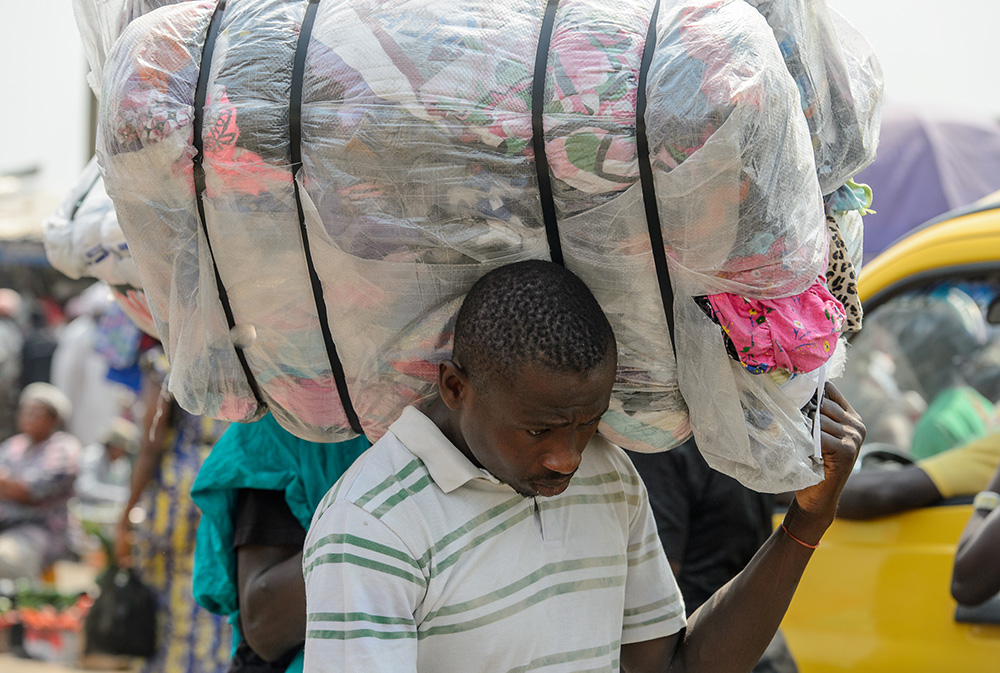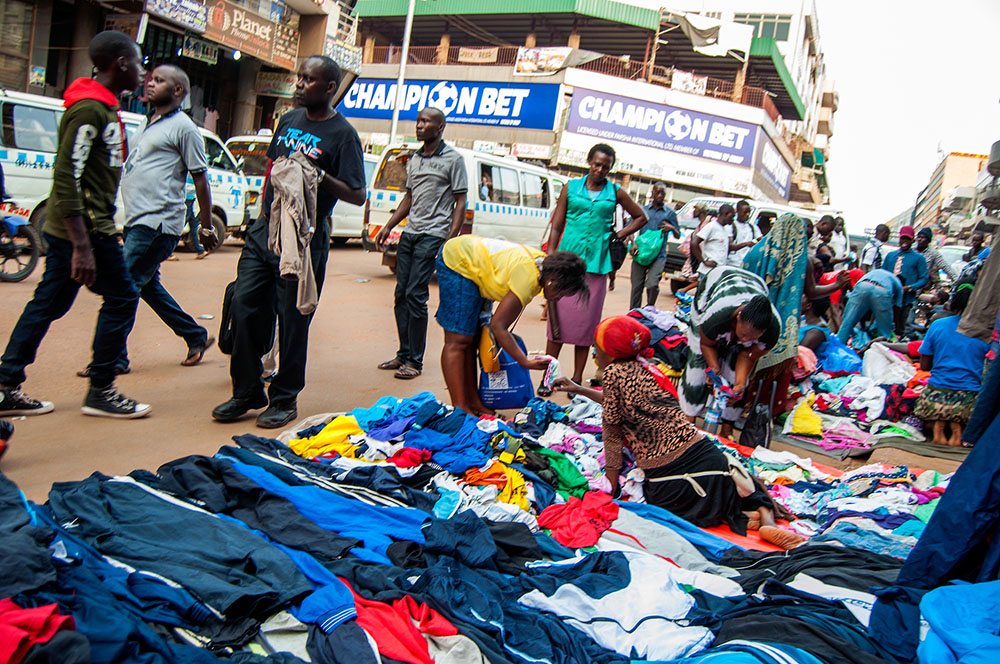
People look through piles of secondhand clothes at a roadside stall in Nairobi, Kenya, April 8, 2018. (AP/Sayyid Abdul Azim)
Bridgette Mwale wakes up at 4:00 a.m. and takes the government-subsidized bus 30 kilometers to Harare, Zimbabwe's capital, three to four times a week. There, she hoards an assortment of secondhand clothing before scurrying back to resell the clothes in the dormitory town of Chitungwiza.
There is an increasing need for inexpensive clothing in the African region. Yet at the same time, secondhand clothing imports are contributing significantly to problems of plastic waste and waste management across the continent.
A new report published in February — "Trashion: The Stealth Export of Waste plastic clothes to Kenya" — has provided insight into the impact of secondhand clothing imports to Africa. From Kenya to Madagascar, Uganda to Nigeria and Zimbabwe to Mozambique, secondhand clothing imports are causing strain on natural ecosystems because the supply far outpaces the demand.
Problems are worsened by poor capacity to process waste and decongest landfills that have themselves become health and environmental hazards.
Bales of secondhand clothing arrive on boats that dock at African ports such as Beira in Mozambique before being trucked to regional cities such as Harare, Lusaka in Zambia, and Lilongwe and Blantyre in Malawi. Shipped from Western countries, the secondhand clothing consignments are transported under the cover of darkness, often facilitated through bribery of authorities such as police and military.
Advertisement
While trade in secondhand clothing imports from the United States, Europe and other western markets is legal in some African countries, it has gone underground in other countries such as Zimbabwe, where the trade is banned.
"I used to order my own bales straight from Mozambique through truckers but ever since COVID-19 hit, I am now mostly going to Mbare to buy secondhand clothing from those opening bales at the market," Mwale told EarthBeat. "I then resell these back here and sometimes I pay for a reselling spot in the Harare CBD [Central Business District] when I get really good quality and top-label clothing that fetches higher prices," said the 40-year-old of Malawian origin.
She is not alone. Thousands of traders hawk secondhand clothing across Africa amid concerns and new evidence pointing to dire consequences. The environmental hazards posed by this rapidly growing trade extend into river, ocean, urban and forest ecosystems across the continent.
The value chain for imported secondhand clothing, most of which is synthetic plastic, is brisk business in many African countries where new clothing is beyond the reach of many. Inflation and other economic difficulties have been driving up costs, stretching disposable incomes and leaving many households unable to afford new clothing and shoes.
This feeds into what is projected to be a rapidly rising global market for secondhand clothing, estimated to notch up an annual growth rate in value of 12.4%, to $27.5 billion by 2029.

A man sells clothes from a van on the streets of Harare, Zimbabwe, May, 1, 2016. (AP/Tsvangirayi Mukwazhi)
Thus Western countries, which house manufacturers of fast-moving clothing lines, have found a ready market to dump fast-fashion pieces as soon as they are discarded by the original owners. This comes as Catholic organizations and parishes across Africa battle plastic waste management challenges worsened by imports of plastic-based secondhand clothing. The excess clothing ultimately becomes waste that is difficult to manage.
The Kenyan report found that "export of used clothing is, to a large extent, the export of plastic waste, burdening communities and the environment" in the receiving countries. In 2021, more than 900 million items of used clothing are estimated to have been exported to Kenya, said the report.
"Secondhand clothing is certainly a part of the larger problem we have with waste in Madagascar," Rado Ravonjiarivelo, environmental compliance program manager for Catholic Relief Services in Madagascar, told Earthbeat.
According to the report, "A large proportion of used clothing ends up dumped on continuously growing landfills in Kenya and polluting the Nairobi River, polluting the watercourse and eventually entering the ocean. As the lion's share of dumped clothing contains synthetics, the impacts of microplastic leaching and environmental contamination of water and soil are likely to be significant."
Findings from other countries have also painted a grim picture of the extent and impact of secondhand clothing imports into Africa from Western nations. The World Bank noted that Madagascar imports approximately 100,000 tons of used clothing each year, with "only a small percentage reused or recycled," according to Ravonjiarivelo.

A man carries a bundle of clothing at the market in Kumasi, Ghana, Jan. 15, 2017. (Dreamstime/Siempreverde22)
According to Hellen Kahaso Dena, communications manager for Greenpeace Africa, the West African nation of Ghana "imports the largest quantities of textile waste" with around 30 million used garments "arriving every fortnight in a country with a population of 31 million."
These quantities "are well beyond any demand for secondhand clothes," Dena said.
As in most African countries, "most of these clothes end up in landfills or burned, causing environmental and health problems as well as increased risks of flooding in urban areas when you have climate events like the cyclones which have become more frequent" in regional coastal countries such as Madagascar and Mozambique. When the clothing is dumped without the capacity to manage waste properly, it blocks drainage in urban areas and riverways, which causes flooding.
Research work and data collection from landfills, rivers and other ecosystems in Uganda point to Western and Chinese source markets.
"Through our brand audits and research work on waste dumped at landfills like Kiteezi in Kampala City, we have found problematic waste, including used clothes with labelling that reads, 'Made in UK,' 'France,' 'Germany' or even 'China' " said Joyce Gwokyalya, a Uganda-based environmental activist with End Plastics Now.
She described the practice of secondhand clothing dumping in Africa by Western countries and China as "an environmental injustice because African countries like Uganda do not have the scale, the expertise or the capacity to manage" this waste.

People sell secondhand clothing on Luwum Street in Kampala, Uganda. (Dreamstime/Tcockrem7)
While the challenges with Western waste-dumping through secondhand clothing imports have mounted, Catholic organizations and parishes are playing a part in providing solutions.
Catholic Relief Services does not distribute secondhand clothing among its humanitarian assistance packages for those displaced internally or those affected by climate-change-induced disasters such as cyclones, floods and droughts. Instead, they repurpose secondhand clothing that is already available in the region.
And some Uganda parishes participate in waste picking and environmental cleanups in partnership with End Plastic Pollution.
"At End Plastic Pollution, we work with Catholic groups including students' environmental clubs in schools and universities. Through Project Kollekt we are educating and supporting waste pickers around the Catholic parish of Masulita," said Gwokyalya.
Dena said that Greenpeace reckons that to stop the flow of textile waste being dumped into African countries from abroad, global fashion brands must start "producing fewer clothes that are designed to be better quality, longer-lasting, repairable" and reusable.
Additionally, development of international legislation such as the United Nations Environment Program's plastic treaty would help prevent countries from dumping excessive quantities of poor quality textiles in the Global South.
"Europe cannot export away its fast-fashion addiction," said Dena.







